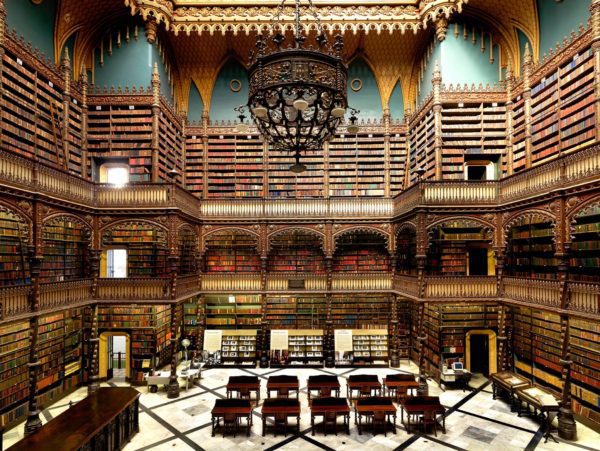Biblioteca Real Gabinete de Leitura, Rio de Janeiro, Brasile
Signed, titled, dated and from edition of 5 on artist’s label on verso.
Available in 3 sizes: 100 x 120 cm. (39.4 x 47.2 in.), 120 x 150 cm. (47.2 x 59.1 in.), 180 x 225 cm. (70.9 x 88.6 in.)
In Massimo Listri’s photograph of the Real Gabinete Português de Leitura in Rio de Janeiro, taken from the second level, the viewer is treated to a breathtaking perspective of the library’s interior. The shot captures the intricate details of the Manuelline ornamentation, the grandiose desk on the floor, and the shelves filled with books on the opposite side of the room, all bathed in light streaming from the cast-iron roof above.
Construction of this magnificent library began in 1880 in the heart of Rio de Janeiro, then the capital of the Empire of Brazil. It was built to commemorate the tercentenary of the death of Luís de Camões (1524-1580), the national poet of Portugal. The Real Gabinete aimed to nurture and spread Portuguese culture, continuing the mission of the first Gabinete Português de Leitura established in 1837 by a group of 43 Portuguese immigrants. These immigrants, predominantly merchants and political refugees, sought to create a reading room in their native language, inspired by the French tradition of ’boutique à lire’ and Masonic libraries in America.
Completed in 1887, the library stands as a testament to memoria, celebrating the Portuguese colony’s European roots and evoking the heroic era of Portuguese exploration through its historicist architecture. The entire building is adorned with sumptuous Manuelline ornamentation and reflects the Portuguese Late Gothic style. This is evident in the carved decor of the bookshelves, the galleries, and the cast-iron roof construction that allows light to flood the interior.
The decorative architectural elements, crafted in limestone, were produced in Portugal and shipped to Brazil for assembly. The library’s façade is a replica of the early 16th-century Jerónimos Monastery in Lisbon, one of Portugal’s most iconic buildings. The monastery is significant as it houses the tombs of King Manuel I (1469-1521) and his family, as well as those of Vasco da Gama (c.1469-1524) and Luís de Camões (c.1524-c.1579). Among the library’s most treasured possessions is a first edition of Camões’ epic poem “Os Lusíadas” (The Lusiads), alongside historically valuable chronicles of Portuguese discoveries.
Since 1906, the library has held the title “Royal,” and it continues to receive deposit copies of every book published in Portugal, making it the largest collection of Portuguese books outside Portugal. This legacy ensures that the Real Gabinete remains a vital cultural institution, preserving and celebrating the rich heritage of Portuguese literature and history.
Listri’s photograph encapsulates the grandeur and historical significance of this library, inviting viewers to appreciate not only the architectural beauty but also the cultural legacy it preserves.
Other Works
Art Inquiry: Biblioteca Real Gabinete de Leitura, Rio de Janeiro, Brasile, Massimo Listri

2012, Printed Later
Archival lambda color photograph
70.9 x 88.6 in
In order to respond to your inquiry, we will will process the personal data you have supplied in accordance with our privacy policy. You can unsubscribe or change your preferences at any time by clicking the link in any emails.







